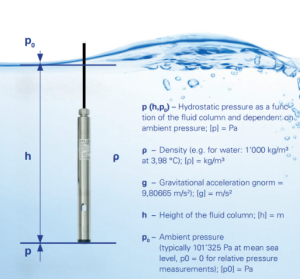Hydrostatic Pressure in Florida Foundations

Hydrostatic pressure is the force that standing water applies against walls, floors, and foundations. In Florida—where heavy rain, a shallow water table, and storm surges are common—hydrostatic pressure is a leading cause of wall cracking, seepage, and basement or crawlspace flooding. At Foundation Waterproofing 101, our systems are designed and installed under the direction of Jeff Earl, water hydraulics engineer, to relieve pressure, move water away, and protect structural integrity.
What Causes Hydrostatic Pressure Around Florida Homes?
- Heavy rainfall & wet season downpours: Florida routinely receives high annual precipitation, driving soil saturation and lateral water pressure.
- High water table: Groundwater may sit just a few feet below grade in many areas; after storms it rises and pushes directly on foundations.
- Poor surface drainage: Flat grades, short downspouts, or no French drains allow water to accumulate around footings.
- Saturated or expansive soils: Waterlogged soils exert thousands of pounds of force per square foot against below-grade walls.
Learn more about Florida moisture best practices and code triggers for hydrostatic conditions:
Florida Building Commission moisture guidance (PDF) ·
Florida Building Code §1805 waterproofing.
Florida by the Numbers

- Rainfall: Typical Florida locations average on the order of ~50+ inches/year (varies by station and region) with intense wet-season events.
- Extreme events: 4″+ rain days occur regularly across the state during the warm season.
- Groundwater: The depth to water table is locally shallow and fluctuates seasonally; post-storm rises increase lateral pressure on foundations.
Explore official data:
NOAA Climate Normals (precipitation) ·
Florida Climate Summary ·
USGS Florida groundwater.
How Much Pressure Are We Talking About?
Rule of thumb: Water adds approximately 0.433 psi per foot of depth (Δp = ρ g h). That adds up fast on a wall.
- 1 ft of water head ≈ 0.43 psi
- 4 ft of water head ≈ 1.73 psi
- 8 ft of water head ≈ 3.47 psi
Example: An 8 ft section of wall (8 ft head at the base) over an area of 8 ft × 10 ft = 80 ft² = 11,520 in² can see several thousand pounds of resultant force. That’s why cracks, bowing, and seepage appear when drainage is poor.
Damage Indicators from Hydrostatic Pressure
- Seepage lines, efflorescence, and damp corners along cold joints and baseboards
- Horizontal or step-cracks in CMU/poured walls; inward wall deflection
- Recurring wet crawlspace or basement after storms; sump pit overflowing
- Musty odor or visible growth (mold can begin forming within 24–48 hours in damp conditions):
EPA guidance
Our Engineering-Driven Solutions
- Interior & exterior drainage to relieve hydrostatic head and intercept groundwater (drainage & French drains)
- Waterproofing membranes and crack injection to block lateral seepage (foundation repair)
- Sump systems with battery backup for controlled discharge during outages (crawlspace waterproofing)
- Regrading, downspout extensions, swales to move surface water off the footprint
- Structural reinforcement where walls show cracking or bowing stress
Hydrostatic Pressure: Quick Reference (Engineering Corner)
- Formula: Δp = ρ g h (water ρ ≈ 1000 kg/m³; g ≈ 9.81 m/s²)
- Imperial shortcut: 0.433 psi/ft of water head; conversely, 2.31 ft/psi
- Design triggers: Florida Building Code requires waterproofing where groundwater investigations indicate hydrostatic conditions
Protect Your Florida Foundation from Hydrostatic Pressure
Florida’s climate — high annual rainfall, a shallow water table, and storm surges — creates constant water pressure on below-grade walls and slabs. When water cannot drain freely, it builds hydrostatic head that forces moisture through cracks, joints, and pores. Left untreated, this pressure can bow walls, cause seepage and mold, and accelerate concrete and steel deterioration.
Foundation Waterproofing 101 designs and installs systems specifically to relieve hydrostatic pressure. Every project is overseen by Jeff Earl, a licensed water hydraulics engineer with 20+ years of field experience. We combine fluid mechanics, site elevation checks, and code-driven design to create drainage and waterproofing solutions that actually work in Florida’s wet seasons.
Our approach can include: properly sized French drains or footer drains above the seasonal water table; sump systems with backup power where gravity discharge isn’t possible; exterior membranes and crack injections to stop lateral seepage; and regrading or downspout extensions to keep water off your footprint. Where walls already show movement or cracking, we can integrate structural reinforcement.
If you see water lines, efflorescence, damp corners, or cracked/bowing foundation walls, don’t wait until damage worsens. Request a professional hydrostatic pressure assessment or call 813-614-4830 today. We’ll verify groundwater levels, pressure loads, and code requirements — then engineer a solution that protects your home long-term.
Schedule an Inspection
If you’re seeing seepage, wall cracking, or recurring water after storms, it may be hydrostatic pressure at work. Get an engineer-led plan to fix it for good.
Call: 813-614-4830
